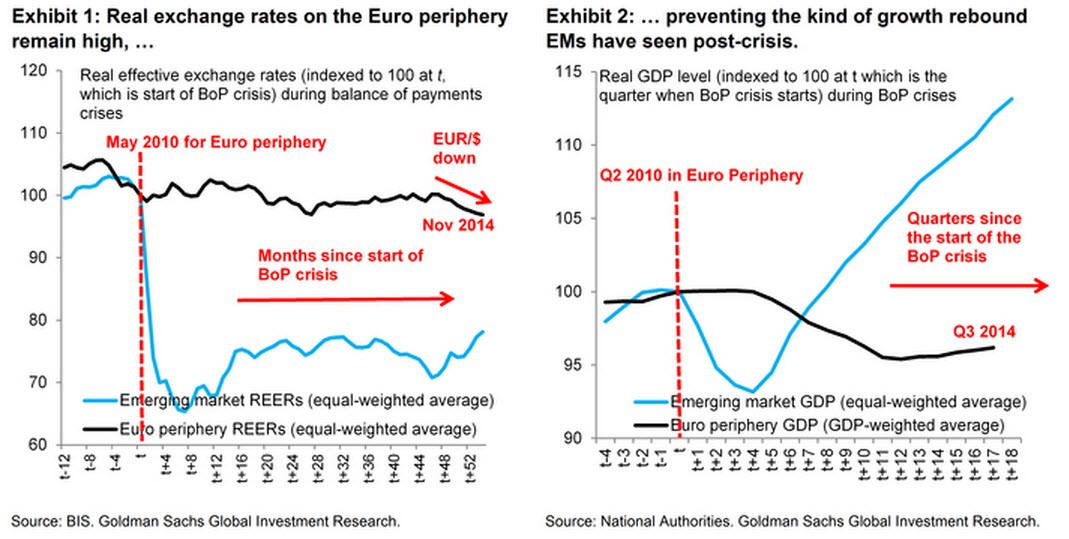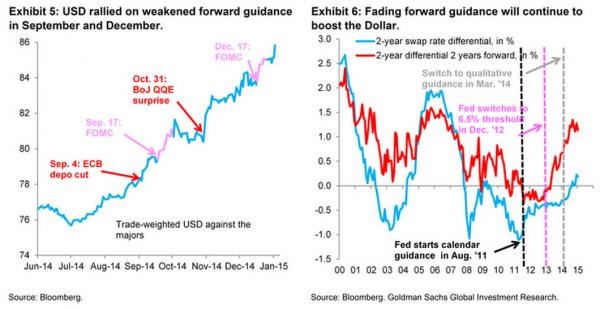Goldman Slashes EURUSD Forecast To
Post on: 16 Март, 2015 No Comment

Having flip-flopped from forecasting EUR strength for the next 12 months in April (target 1.40), Goldman has rapidly ratcheted down its expectations for the flailing currency to 1.30 previously and now forecasts EURUSD at 1.20 in 12 months. As Goldman notes, because we believe the dynamics of the Euro have fundamentally changed and because we expect cyclical outperformance of the US, a prolonged period of Euro undervaluation can be expected and this is reflected in our longer-term forecasts. Trade accordingly.
Via Goldman Sachs,
1. We are revising down our EUR/$ forecast to 1.29, 1.25 and 1.20 in 3, 6 and 12 months (from 1.35, 1.34 and 1.30 previously). We are also revising our longer-term forecasts lower, bringing the end-2015 number down to 1.15 (from 1.27), that for end-2016 to 1.05 (from 1.23) and that for end-2017 to 1.00 (from 1.20). We switched from forecasting Euro strength to weakness in April, when we revised our 12-month forecast from 1.40 to 1.30, and the decline since then has been faster than we anticipated. Our latest forecast change aims to signal that the current move lower in EUR/$ has staying power and, in our view, is the beginning of a trend.
2. This forecast change is very much a restatement of our bullish Dollar view. Indeed, because we are keeping our EUR/CHF, EUR/GBP, EUR/NOK and EUR/SEK forecasts unchanged, this change is disproportionately important for our trade-weighted Dollar forecast. When we first switched to forecasting Euro weakness in April, this implied a 6% appreciation of the trade-weighted Dollar against the G10 on a 12-month horizon. Since then the Dollar has appreciated about 3%, i.e. about half that, thanks in large part to the drop in EUR/$. Revising our 12-month EUR/$ forecast to 1.20 implies a trade-weighted appreciation of the Dollar against its G10 peers of a further 6%. We think the USD still has room to catch up with the 2-year rate differential, which is currently the most Dollar-supportive since mid-2009 (Exhibit 1). In addition, changes to the Fed’s forward guidance in coming months have the potential to move the rate differential further in support of the Dollar (Exhibit 2), especially if US data continue their cyclical outperformance versus the rest of the G10.
3. We also believe that the dynamics of the Euro have fundamentally changed. Prior to the ECB’s latest round of easing in June, the foreign exchange market was very sceptical that additional monetary stimulus could be Euro-negative, since it would attract foreign inflows that would buoy the single currency. That thinking has changed fundamentally, in our view, not because foreign portfolio flows into the Euro area have abated (Exhibit 3), but because domestics are increasingly sending portfolio flows out of the Euro area, as ongoing ECB easing encourages a hunt for yield elsewhere (Exhibit 4). Our view is that these portfolio outflows have much greater potential to grow than foreign flows into the Euro area, given that periphery risk premia are already so compressed. Key pushbacks to our view are that: (i) speculative short Euro positioning is already very stretched, with the CFTC’s CoT report for example putting positioning now on a par with 2011/12, when concerns about a potential Euro area break-up were very real; and (ii) the view that the ECB is de facto on hold, as it implements easing measures announced in June. As we have argued in a recent FX Views, the large size of foreign portfolio inflows into the Euro area over the last two years likely means that the CoT report overstates speculative Euro shorts, which we see as moderate in the scheme of things. As far as ECB policy goes, we think there is – counter to market consensus – plenty of room for President Draghi to ‘talk’ the currency lower, which he notably started to do in the August press conference when he said that “fundamentals for a weaker exchange rate are today much better than they were two or three months ago”. Reinforcing his comment, we estimate that the fair value for EUR/$ is around 1.19. Therefore, even with the depreciation of the Euro in recent months, it is still expensive. Because we believe the dynamics of the Euro have fundamentally changed and because we expect cyclical outperformance of the US, a prolonged period of Euro undervaluation can be expected and this is reflected in our longer-term forecasts.
4. Our 12-month EUR/$ forecast of 1.20 implies a 5% weakening of the Euro on a trade-weighted basis versus the G10. With our 12-month forecast for EUR/GBP unchanged at 0.75, this amounts to a downgrade to our GBP/$ view, with the 12-month forecast now 1.60 (from 1.73 previously). As a result, we are now expecting somewhat less appreciation of Sterling, with the trade-weighted index rising well below 5% on a one-year horizon, down from 6% earlier this year.
* * *

Bear in mind this is Goldman Macro not the FX team (ex Stolper).
* * *
The herd chimes in:
- *JPM CUTS 1Q EUR/USD EST TO 1.28 VS 1.30; 2Q EST TO 1.26 VS 1.28














